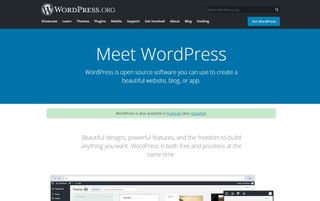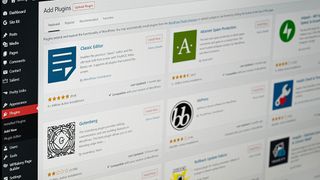WordPress for Beginners: Everything you need to get started
[ad_1]
In this WordPress beginner’s guide, we’re going to get to the point on how best to use the website builder. WordPress is a huge platform that allows you to create websites and blogs on a large scale. There’s a lot to understand, so we’ve put together this beginner’s guide to answer some of the most frequently asked questions about the platform.
In this guide, we’ll look at how much it costs and how to get started. If you’re here, you’ve probably already looked at some of the best website builders out there. Long story short, WordPress is one of our favorite free website builders, but there are alternatives. Check out the deals below or scroll down to our WordPress Beginner’s Guide.
Best alternatives to WordPress for beginners

02. HostGator: Easy to use and inexpensive
Hostgator is another great, affordable choice to get a simple website up and running quickly? With a drag-and-drop editor and 150 templates to choose from, it’s easy to set up with no coding required
WordPress for beginners
Perhaps you are a creative professional and you want to build your online portfolio. Or maybe you are an agency that needs an online base. Regardless of your intentions and purpose, WordPress is one of the best ways to create a website, blog, or ecommerce store. Here we look at what it is and how to get started.
01. What is WordPress?
WordPress is more than just a website builder; It is a content management system (CMS) that allows you to create, publish, and maintain websites and blogs of all types and sizes. In fact, 40% of all websites on the internet are powered by WordPress. It is the leading platform for creating and managing websites and blogs. Best of all, you don’t even need to know how to code HTML, PHP, or CSS – although coding knowledge can be used to make advanced customizations if you so choose.
WordPress is open source. This means that anyone who uses the software can freely modify it to suit their needs. This has led to the development of a large number of “plugins”, modifications that change the core functionality of WordPress. These plugins are the main reason people love WordPress. They allow you to create almost any type of website.

People often confuse WordPress.com and WordPress.org. WordPress.org is the content management system – a platform that allows you to create and manage websites for free. However, WordPress.org is self-hosted, which means you will still have to pay for your web hosting and domain registration yourself to get your website started.
WordPress.com, on the other hand, is a for-profit website builder that allows you to quickly and easily set up a website and take care of website creation, web hosting, and domain registration for a fixed price. WordPress.com is easier to use, but it lacks many of the powerful features that make WordPress.org great, such as: B. Plugins. However, WordPress.com and WordPress.org share a similar user interface.
03. How much does WordPress cost?
WordPress.org – the central content management system – is available free of charge. However, the word “free†is often misunderstood. While the platform itself is free, you still have to pay for web hosting and domain registration to get your website up and running.
Web hosting is the storage space and processing power needed to keep your website working, while domain registration is the link that leads to your website. Think of it as similar to the office space and brand names you need to start a real business. Web hosting and domain registration can cost different amounts depending on the computing power required and the popularity of the selected domain.
04. How do I install WordPress
Getting started with WordPress is very easy. All you have to do is install it through your preferred web hosting provider. Most web hosting companies offer dedicated tools that allow you to do this with just a few clicks. You can also opt for managed WordPress hosting for a premium fee by using your web hosting company’s own experts to set it up and maintain it so you can focus solely on building your website.
If you are the do-it-yourself type, you can of course always install WordPress directly via your web hosting provider’s FTP program. Simply upload the files you need via your FTP server and set up the database with MySQL. For detailed instructions on installing WordPress, see the official guide.
05. How to install a WordPress theme
Once you’ve set up WordPress through your hosting provider, you’re actually ready to build your website. WordPress websites consist of predefined layouts or “themes”. These themes can either be downloaded for free, purchased online, or customized by a web designer.
If you just want to get your website live asap, consider downloading one of the many free themes available online or purchasing a premium theme for added functionality. ThemeForest has a large collection of WordPress themes. However, if you have the budget and the time, it is always the best idea to hire a web designer to create a custom theme for your website.
You can install any theme by uploading the zip file to your website by going to Appearance> Themes> Add New> Upload Theme in your WordPress admin. Some themes may require further customization in order to work properly.
06. How to install a WordPress plugin

To install plugins you will need to access your website’s admin panel by going to yourdomain.com/wp-admin. Once you are in the WordPress admin you can navigate to Plugins> Add New. From there you can either search for a free plugin using the search bar or upload a ZIP file for a premium plugin.
07. How to add pages to your WordPress site
WordPress websites are made up of two elements: static pages and dynamic blog posts. The idea is that pages should be updated every now and then, while blog posts should be constantly updated with the latest information. Of course, there is no actual limit to the minimum or maximum number of times a page or post can be updated. To add a new static page to your website, go to Pages> Add New. You can then enter a title and add the required content before clicking Publish.
08. How to publish your first blog post on WordPress on
Blog posts are the individual articles that make up your blog. They are updated frequently so that they are dynamic. To start your first blog post in WordPress, just go to Posts> Add New. There you can enter the title, content and metadata for your blog post and click Publish. Different topics offer different ways to customize your blog posts to make them stand out from other blogs and websites.
There are several ways to add media files such as pictures and videos to your blog. The first is to go straight to Media> Add New. However, this just uploads the media file to your website gallery without displaying it on any particular post or page. You can also go straight to the blog post or static page you want to add the media file to and upload the required content using Gutenberg, the built-in rich text editor for WordPress.
10. How can you make money with WordPress?
There are a number of ways that you can make money from your WordPress blog or website. The most common method is by showing affiliate advertisements. You can use a service like Google Adsense to do this. You can also sell advertising space directly.
Other ways to make money include setting up an online store, providing special services, creating paid content, starting a subscription, or teaching an online course. It all depends on your own skills and knowledge.
On the subject of matching items:
[ad_2]

